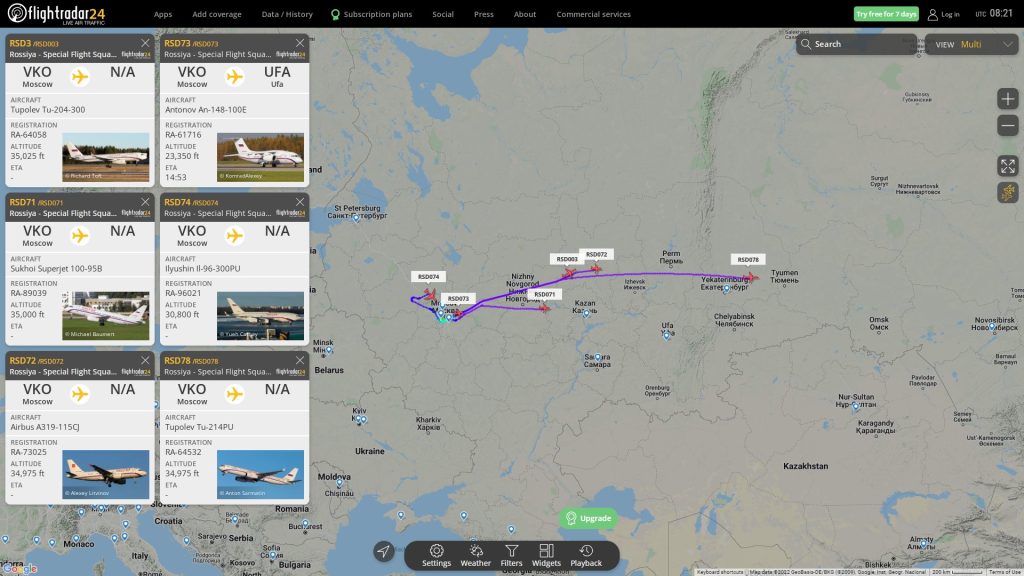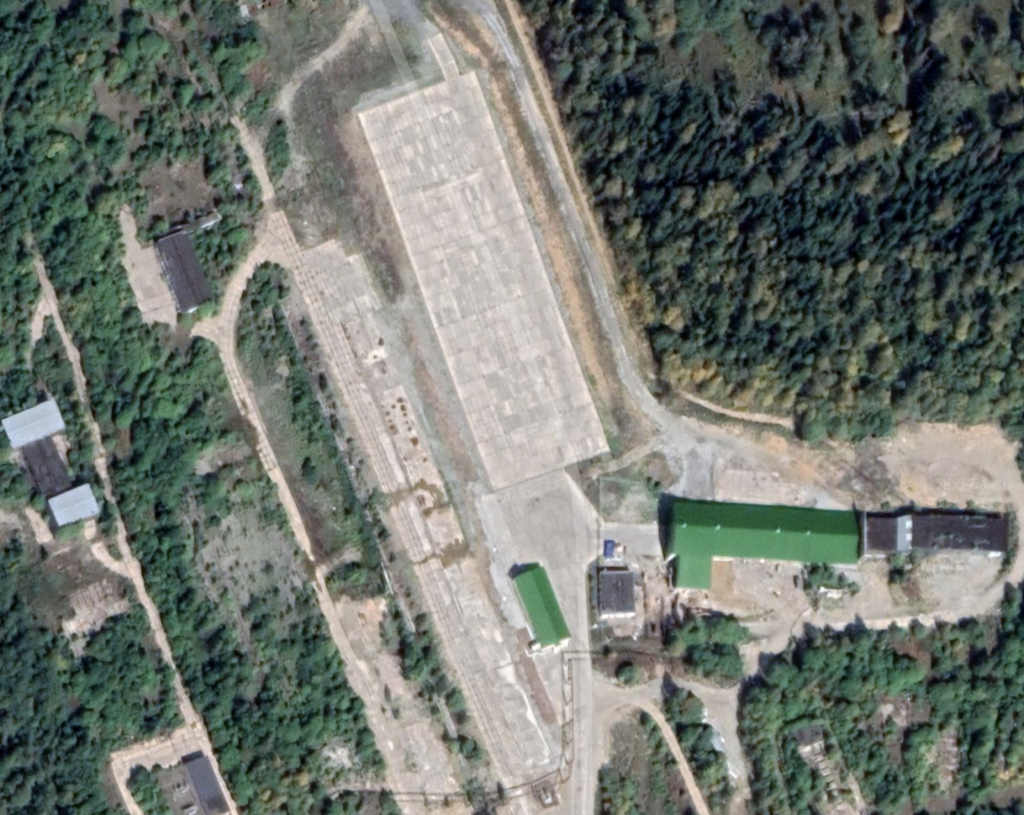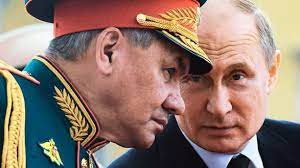Russia demonstrates it is ready to evacuate the government and permanent members of the Security Council, in case of nuclear threat.
223 aviation squad is involved to accomplish that task, including:
– RuAF command post Tupolev Tu-214PU RSD78
-RuAF Tupolev Tu-204-300 RSD3
-RuAF Sukhoi Superjet 100-95B RSD71
-RuAF A319-115CJ RSD72
-RuAF An-148-100E RSD73
-RuAF Ilyushin Il-96-300PU RSD74
– RuAF airplane-repeater Tupolev Tu-214SR RSD79
-RuAF SuperJet 100-95B RSD80.
The aircraft took off from Vnukovo airport (the basic airfield).

All the aircraft from the convoy have landed in various Russian cities. The first aircraft to take off, Tupolev Tu-214PU (reg. RA-64532), landed in Novosibirsk (OVB), before taking off again 22 minutes later and heading back in the direction of Moscow, followed by at least one other aircraft (Airbus A319-115CJ, reg. RA-73025). RA-64516 communications relay aircraft landed in Omsk, before later taking off for Moscow as well. The remaining aircraft landed in Surgut, Tyumen, Omsk, and Ufa as well as several other cities in Russia.
Tender purchases for 223 squadron, that owns these aircraft, do not reveal fuel or other services were bought for those airfields. But in April 2015, the squadron purchased accommodation services for aviation personnel at the Anzas Hotel in the city of Abakan. Aside from that, Abakan bought a lot of aviation fuel for 223 squadron. That means the Abakan airfield used to receive flights of top officials who stayed in the city for several days. Further study of the developments at the Abakan airfield revealed that the presidential airplane used to fly frequently from Moscow to Abakan, often accompanied by a flying command post and Defense Minister Sergei Shoigu’s plane. In March 2021, for example, Putin and Shoigu flew to Abakan for a vacation in the taiga (the Kremlin claims officially). Regular flights on this route have been made, starting from 2013.
But flights on March 16-17 were not to Abakan, which means there are some options for the top officials to be evacuated to different locations or it is a show to divert attention from the key goal. The flight was detected due to the transponders turned on, which means Moscow wanted it to be visible. Moreover, the flight was highlighted by Kremlin-backed telegram channels, indicating the task was to practice the evacuation of top Russian officials in case of a nuclear threat. Having put the nuclear forces on high alert, therefore, the Kremlin is showing it is ready to make a nuclear assault, that probably being either part of an information and psychological campaign, or it is getting ready or anticipates for a nuclear strike.
Vladimir Putin is considered to be the “reincarnation” of the Third Reich leader – Adolf Hitler. Somehow their tactics, rhetoric, and doctrines coincide. Putin is the kind of person who doesn’t know what it is like to lose. And when it comes to a massive defeat, he starts to feel stuck in the corner. However, he (exactly his person, not even the state) possesses nuclear warheads that can lead the world to the endgame.

Read also: Russia’s political line: neo-Nazism
Russian soldiers came to Ukraine with one real goal: dying for the ambitions of a bunker guy. Denazification and demilitarization are claimed to be the minimum to reach. Russian propaganda uses various fake facts about the “development of nuclear and biological weapons” in Ukraine, which can be used against Russia. Recalling the comparison between the Third Reich and the Russian Federation, we must understand that the first one couldn’t pose a nuclear threat to the international community. Nowadays, this threat is much more serious than it was even during the Cold War.
The despair of a dictator
Putin is losing consciousness. He had a plan relying on the false intelligence data. Now he is in the condition of a Brownian movement, and the idea of world nuclear war seems for him to be more and more realistic. He understands that his regime is coming to its finish line, but he doesn’t want the world without him. Many medical conclusions prove that Putin’s health condition is getting worse. That’s one of the reasons why his ambitions can have not only catastrophic but annihilating implications.
The Ukrainian Fiasco
The military march into Ukraine did not work out. Kyiv has become a severe bone in Russia’s throat. As Putin is running out of conventional maneuvering options, he comes closer to making nuclear threats into reality. Putin thinks that the world betrayed him, that Russia is surrounded by traitors. And he is ruled by a simple affirmation: “To attack is the best way to defend.”
The Russian president is dragging his entourage into an abyss of madness.
Doomed clique
According to Kremlin sources, Putin’s clique is bound by fear and despair right now. As they have been cut off Western accounts and property, Russia’s political, military, and business leaders have nothing to lose. They are obsessed with a super-idea, and the rest of the world has no means of redeeming itself from hostages other than to accept all the points of their ultimatum, that is, to capitulate.
Putin’s clique is done for, which makes them cluster together around the idea of a doomsday not only for them but for the whole world. They realize that nuclear retaliation from the West aims at the European part of Russia, whereas they can hide in the bunkers somewhere in Altai.
Evacuation bases of Abakan and Yamantau, in this regard, where the main bunker is located, with new facilities and active infrastructure development observed, should be among the targets for possible retaliation on Russia. Yamantau is not far from Ufa, providing rapid transfer for protected figures to the bunker by helicopters.
YamantauCIA-RDP84T00171R000301360001-9The new buildings appeared in 2020, that is, simultaneously with the coronavirus epidemic. The Yamantau bunker, therefore, may have been prepared over both nuclear and biological threats.

There is every possibility, however, the Kremlin staged the transfer of political leaders to that bunker on March 17-18.
Nuclear readiness
Since 1999, tactical nuclear weapons have played a well-defined role in Russian military strategy as so-called “de-escalation” weapons. Such a strategy increases the likelihood of fear-mongering to use them during a conflict. Russia conducted tactical nuclear attack drills as part of the “Zapad” exercises. During previous drills in 2009 and 2013, the Russian army practiced an atomic strike against Warsaw.
Again and again, Russia’s leadership reminded the West that it could destroy its major cities and industrial centers. Back in 2007, General Alexander Vladimirov spoke about the inevitability of war between Russia and the United States in the next 10-15 years.
In 2011, General Nikolai Makarov, Chief of the General Staff of the Armed Forces, stated that he did not exclude that local and regional armed conflicts could escalate into a large-scale war, including nuclear weapons. What in 2011 was presented as a hypothetical possibility turned into outright threats in March 2014, during the annexation of Crimea, and is now almost an accomplished fact. The Kremlin warned that any attempted military intervention by Western forces would be met with a nuclear attack. On March 16, 2014, the day of the “referendum” on the annexation of Crimea, Dmitri Kiselev, a prominent Kremlin-backed broadcaster, claimed that Russia was the only country in the world capable of turning the United States into “a pile of radioactive ash”. Assault on Ukraine is yet another step of Russia’s spiraling towards a nuclear conflict.
In response to sanctions from the West, Putin ordered that Russian deterrence forces be placed on special alert at a meeting in the Kremlin with Defense Minister Sergei Shoigu and General Staff Chief Valery Gerasimov.
The President, the head of the Ministry of Defense, and the chief of the General Staff have nuclear suitcases in Russia. These three men have gathered to announce the strengthening of the deterrent forces. The keys to the nuclear suitcases are in the hands of the operating officers and it is enough to activate two of the three systems to start a nuclear war. This chain of reaction will likely work.
We can see the same resolve from Russian diplomats. Dmitry Polyansky, deputy permanent representative of Russia to the UN, considers possible the use of nuclear weapons in case of provocation by NATO.
If Putin wants to keep NATO out and believes he can destroy the Alliance, he will probably use tactical nuclear weapons. Probably he will use it in depopulated areas of Ukraine, or perhaps at military infrastructure or in some populated area in Poland. The most likely scenario is a low-yield nuclear strike against Warsaw, which Russia repeatedly practiced in its exercises.
Russian military doctrine dwells on the concept of a first strike, so if Moscow decides to do so and a response does not follow the attack, it will use nuclear weapons.
The problem is that a tactical strike on Europe risks spiraling down into the use of strategic nuclear warheads and full-scale nuclear conflict between the major nuclear states. The hypothetical logic of nuclear escalation is such that it will eventually lead to the total mutual destruction of everything.
We can see now that threats of nuclear weapons and such deviant behavior were not merely meant to provoke the Western alliance to test its nerve. They served as a rehearsal for an incident that could be used as a pretext for military action by Russia. Now aggression into Ukraine had been used as such a handy excuse.
The attack on Ukraine demonstrated that Russia had broken the old international consensus on the inviolability of borders. The situation has changed. People in Europe cannot sleep peacefully. Putin’s propensity for unpredictable actions risks igniting a larger conflict in the heart of Europe that could lead to world war.
Putin may consider a nuclear strike as a way out of the war.
So Putin is prepared to pull the nuclear trigger. He is like a poker player who has lost his footing: after a series of successful rounds, he made a big bet, a blitzkrieg in Ukraine. But he’s lost. Now it’s all in. And it is unlikely that anyone can stop this crazy bet.
Russia’s fear-mongering will be a harsh lesson for us and our children. Every step that brought us closer to catastrophe will be studied. Unless, of course, the war escalates into a nuclear war, and there will be someone to study it.




